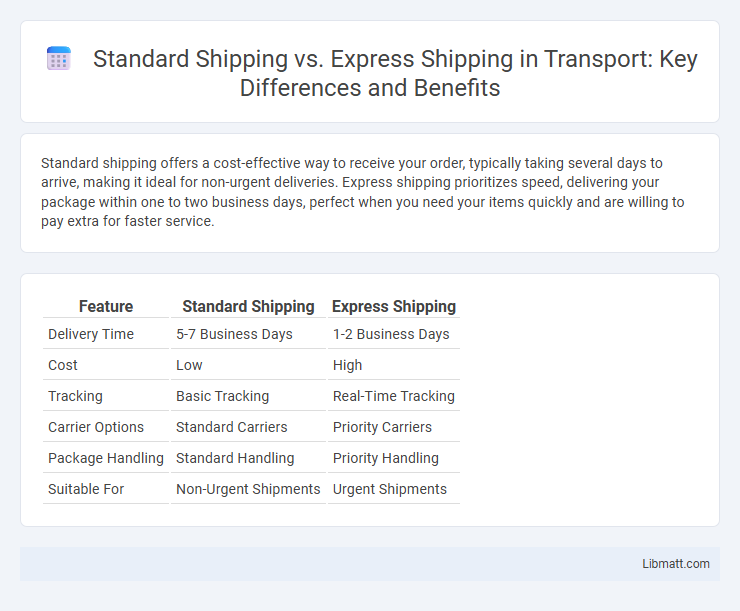Standard shipping offers a cost-effective way to receive your order, typically taking several days to arrive, making it ideal for non-urgent deliveries. Express shipping prioritizes speed, delivering your package within one to two business days, perfect when you need your items quickly and are willing to pay extra for faster service.
Table of Comparison
| Feature | Standard Shipping | Express Shipping |
|---|---|---|
| Delivery Time | 5-7 Business Days | 1-2 Business Days |
| Cost | Low | High |
| Tracking | Basic Tracking | Real-Time Tracking |
| Carrier Options | Standard Carriers | Priority Carriers |
| Package Handling | Standard Handling | Priority Handling |
| Suitable For | Non-Urgent Shipments | Urgent Shipments |
Understanding Standard Shipping
Standard shipping offers a cost-effective delivery option with typical transit times ranging from 5 to 7 business days, making it ideal for non-urgent purchases. This method often includes basic tracking features and reliable service through regular postal or courier networks. Understanding standard shipping helps you balance affordability and delivery expectations when ordering online.
What Is Express Shipping?
Express shipping is a faster delivery service that prioritizes your package for quicker transit times, often reducing delivery from several days to 1-2 business days. It uses expedited logistics networks and may include options like overnight or same-day delivery, ensuring urgent items reach their destination swiftly. Choosing express shipping means paying a premium for speed and reliability compared to standard shipping's slower, cost-effective approach.
Key Differences Between Standard and Express Shipping
Standard shipping typically takes 5-7 business days with lower costs, while express shipping offers delivery within 1-3 business days at a premium price. You can expect standard shipping to prioritize cost-effectiveness, whereas express shipping prioritizes speed and reliability for urgent deliveries. Tracking options and shipping insurance may vary, with express services often providing more comprehensive support.
Delivery Times: Standard vs Express
Standard shipping typically delivers packages within 5 to 7 business days, providing an economical option for non-urgent orders. Express shipping reduces delivery times significantly, often guaranteeing arrival within 1 to 3 business days, perfect for time-sensitive purchases. Your choice between standard and express shipping depends on how quickly you need the item and your budget for delivery speed.
Cost Comparison: Standard vs Express Shipping
Standard shipping generally costs significantly less than express shipping, making it the preferred choice for budget-conscious shoppers. Express shipping, while more expensive, offers faster delivery times that may justify the higher fee for urgent orders. Your decision should balance delivery speed needs with the added cost to optimize shipping expenses effectively.
Reliability and Tracking Options
Standard shipping offers reliable delivery with basic tracking updates that keep customers informed of their package's status throughout transit. Express shipping enhances reliability through faster delivery times and provides more detailed, real-time tracking features, allowing for precise monitoring from dispatch to arrival. Customers seeking speed and comprehensive tracking prefer express options, while those prioritizing cost-effective, dependable delivery may opt for standard shipping.
When to Choose Standard Shipping
Choose standard shipping when cost savings are a priority and delivery time is flexible, typically ranging from 5 to 10 business days. This option suits non-urgent purchases like bulk orders, household items, or seasonal products where immediate arrival is not critical. Standard shipping is ideal for customers seeking affordable rates without requiring expedited logistics or guaranteed delivery windows.
When to Opt for Express Shipping
Express shipping is ideal when you need your package delivered quickly, such as for last-minute gifts, urgent business documents, or time-sensitive products. Standard shipping suits non-urgent deliveries, offering a cost-effective option with longer transit times. Your choice depends on balancing delivery speed against shipping costs to meet your specific deadline requirements.
Customer Expectations and Satisfaction
Express shipping meets customer expectations for fast delivery, significantly enhancing satisfaction by reducing wait times and providing real-time tracking updates. Standard shipping, while more economical, can lead to varying satisfaction levels due to longer delivery windows and less frequent status updates. Understanding these preferences enables businesses to tailor shipping options that balance cost and customer experience effectively.
Which Shipping Method Is Best for You?
Choosing between standard shipping and express shipping depends on your budget and urgency. Standard shipping is cost-effective for non-urgent deliveries, typically taking 5-7 business days, while express shipping offers faster delivery within 1-3 business days at a higher price. Evaluate your timeline and cost preferences to determine which shipping method is best for you.
standard shipping vs express shipping Infographic

 libmatt.com
libmatt.com